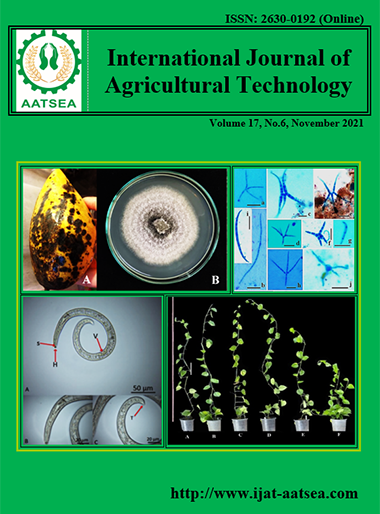Effects of natural colorants on physicochemical properties and sensory acceptance of Nham
Main Article Content
Abstract
Nham is a traditional fermented meat product of Thailand made from ground pork. In the production process, chemicals such as nitrate or nitrite compound are commonly used as the ingredients to maintain its pink color. However, if these chemicals are used in improper amounts, they may be harmful to the customer’s health. In this study, the effects of three natural colorants, rosella flower powder, tomato powder, and safflower powder at three levels (0.2, 0.4 and 0.6% w/w) were reported by comparing with the control formula and the formulas containing sodium nitrite. The results showed that, pH values decreased and total acidity represented by lactic acid content increased continuously as the fermentation time increased. An increase in natural colorant content resulted in decrease in lightness (L*) and increase in redness (a*) and yellowness (b*). All three types of natural colorants at all levels affected the texture characteristics and sensory acceptance (p<0.05), but had no effect on proximate composition of Nham (p≥0.05). All types of natural colorant at all levels resulted in higher hardness, adhesiveness, cohesiveness, springiness and chewiness compare to the control formula. Nham samples with 0.4% and 0.6% tomato powder showed no difference in sensory scores for color, flavor, taste, and firmness compared to the control formula (p≥0.05). Nham sample with 0.4% tomato powder showed the highest sensory scores for all attributes. Thus, 0.4% w/w tomato power was shown to be the optimum natural colorant as an alternative to nitrate and nitrite in Nham products
Article Details

This work is licensed under a Creative Commons Attribution-NonCommercial-NoDerivatives 4.0 International License.
References
AOAC (2000). Official methods of analysis. Association of Official Analytical Chemists, Washington, DC.
Bureau of Nutrition, Department of Health (2018). Food composition table of Thai food. Thailand, Ministry of Public Health.
Calvo, M. M., GarcÍa, M. L. and Selgas, M. D. (2008). Dry fermented sausages enriched with lycopene from tomato peel. Journal of Meat Science, 80:167-172.
Cassens, R. G. (1997). Composition and safety of cured meats in the USA. Journal of Food Chemistry, 59:561-566.
Choski, P. M. and Joshi, V. Y. (2007). A review on lycopene: Extraction, purification, stability and applications. International Journal of Food Properties, 10:289-298.
Doménech-Asensi, G., García-Alonso, F. J., Martínez, E., Santaella, M., MartínPozuelo, G., Bravo, S. and Periago, M. J. (2013). Effect of the addition of tomato paste on the nutritional and sensory properties of mortadella. Journal of Meat Science, 93:213-219.
Kirca, A., Özkan, M. and Cemeroglu, B. (2006). Stability of black carrot anthocyanins in various fruit juices and nectars. Journal of Food Chemistry, 97:598-605.
Kramlich, W. E., Pearson, A. M. and Tauber, F. W. (1973). Processed meats. AVI Publishing Co. Inc., Westport, CT.
Kwanmuang, P. (2011). Development of pork spareribs and middle wing chicken Nham fermentation by using starter cultures and herb gardens. King Mongkut's Institute of Technology Ladkrabang, Bangkok: pp.51.
Mohamed, B. B., Sulaiman, A. A. and Dahab, A. A. (2012). Roselle (Hibiscus sabdariffa L.) in Sudan, Cultivation and Their Uses. Bulletin Of Environment, Pharmacology and Life Sciences, 1:48-54.
Rattanapanone, N. (2014). Food chemistry (5thed). Bangkok, Thailand, Odeon store Publishing.
Pourazrang, H., Moazzami A. A. and Fazly B. S. (2002). Inhibition of mutagenic N-nitroso compound formation in sausage sample by using L-ascorbic acid and α-tocopherol. Journal of Meat Science, 62:479-483.
Rojanak, N. (1995). Natural color. Department of Science Service Ministry of Highe Education, Science, Research and Innovation, 43:3-6.
Saksomboon, K., Meemookich, S., Kaewsaad, T., Limroongreungrat, K. and Theprugsa, P. (2020). Effect of tomato powder on quality of Chinese sausage. Int. Journal of Agricultural Technology, 16:711-720.
Sanoppa, K., Meesangket, S., Aemchalee, W. and Wongwan, P. (2021). Effects of Supplementation with Pigment Powders from Monascus purpureus Fermented with Pisang Awak Banana (Musa sapientum Linn.) Replace Nitrite in Fermented Pork Sausage (Nham). Journal of KMUTNB, 31:99-108.
Shahidi, F. and Pegg, R. (1991). Novel Synthesis of Cooked Cured-Meat Pigment. Journal of Food Science, 96: 1205-1208.
Suksripaisal, C. and Theprugsa, P. (2017). Use of Tomato and Ang-kak Powder in Chinese Sausage. Journal of Science and technology Thammasat university, 27:252-263.
Rojsuntornkitti, K., Jittrepotch, N., Kongbangkerd, T. and Kraboun, K. (2010). Substitution of nitrite by Chinese red broken rice powder in Thai traditional fermented pork sausage (Nham). International Journal of Food Research, 17:153-161.
Thai Industrial Standards Institute (2004). Thai industrial standard, Naem (fermented ground pork) TIS. No.1219. Thailand, Ministry of Industry.
Tirasarot, J. and Thanomwong, C. (2014). The utilization of Ang-Kak for color in the emulsion fish sausage. Journal of KKU Science, 42:169-175.
Valyasevi, R., Smitinond, T., Praphailong, W., Chowvalitnitithum, C., Kunawasen, S. and Chavasith, V. (1999). The microbiology and development of starter cultures for nham, the Thai pork sausage. In: Tuijtelaars, A. C. J., Samson, R. A., Rombouts, F. M., Notermans, S. (Eds.), Food Microbiology and Food Safety into the Next Millenium. TNO Nutrition and Food Research Institute, A. J. Zeist, pp.709-711.
Visessanguan, W., Benjakul, S., Panya, A., Kittikun, C. and Assavanig, A. (2005). Influence of minced pork and rind ratios on physicochemical and sensory quality of Nham a Thai fermented pork sausage. Journal of Meat Science, 69:355-362.
Visessanguan, W., Benjakul, S. Riebroy, S. and Thepkasikul, P. (2004). Changes in composition and functional properties of proteins and their contributions to Nham characteristics. Journal of Meat Science, 66:579-588.
Visessanguan, W., Benjakul, S., Smitinont T., Kittikun, C., Thepkasikul, P. and Panya, A. (2006). Changes in microbiological, biochemical and physico-chemical properties of Nham inoculated with different inoculum levels of Lactobacillus curvatus. LWT - Food Science and Technology, 39:814-826.


